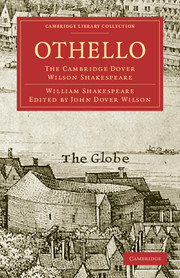INTRODUCTION
Published online by Cambridge University Press: 07 September 2010
Summary
The Moor
Shakespeare wrote two plays about Venice, the comedy or tragi-comedy of The Merchant of Venice and The Tragedy of Othello, the Moor of Venice, the most conspicuous figure in both being an alien. Shylock is a despised outcast from the ghetto; Othello a distinguished general of the republic, honoured by the council of state, and trusted by the senators; yet isolation from the society of Venice is insisted upon in both cases. With Othello, indeed, it is kept constantly before our eyes on the stage from first to last by the mere fact that he is black. And whatever facial characteristics the actor who plays him may possess or assume, Bradley was undoubtedly correct in his belief that Shakespeare intended us to think of him as a Negro. That is what ‘Moor’ meant to Englishmen in the Middle Ages and at the time of Elizabeth and James. Roderigo's contemptuous reference to ‘the thick-lips’ may be prejudiced evidence, but it should at least have warned nineteenth-century producers and their successors that to present the Moor of Venice as a bronzed and Semitic-featured Arabian prince might seriously disfeature the play. We are not told how Othello's hair grows but we learn that Aaron ‘the Moor’ in Titus Andronicus is not only ‘coal-black’ and ‘thick-lipped’ but has a ‘fleece of woolly hair’, while in The Merchant of Venice (3. 5. 35–6) Negro and Moor are treated as identical terms.
- Type
- Chapter
- Information
- OthelloThe Cambridge Dover Wilson Shakespeare, pp. ix - lviPublisher: Cambridge University PressPrint publication year: 2009First published in: 1957

